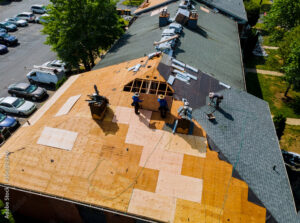Roofing refers to the covering of a building and all the materials and constructions that support it. A roof provides a building with a layer of protection against sunlight, weather, extreme temperatures, and wind. As the topmost covering of a building, it is considered a vital part of the building’s envelope. Learn more about Roofing McKinney TX. Roofing materials are used for many reasons. Here are just a few:
 Gable: Gable roofs are easy to measure, while gambler and mansard roofs are more difficult. Intricate roofing forms require more complicated calculations and waste is often a major issue. This waste is caused by shingles that need to be cut to fit tight spaces or are nailed into place evenly along the roof deck. Other components of a roof include the sheathing and skirt flashing. The finished underside of the eave is known as the soffit.
Gable: Gable roofs are easy to measure, while gambler and mansard roofs are more difficult. Intricate roofing forms require more complicated calculations and waste is often a major issue. This waste is caused by shingles that need to be cut to fit tight spaces or are nailed into place evenly along the roof deck. Other components of a roof include the sheathing and skirt flashing. The finished underside of the eave is known as the soffit.
The felt paper should be stapled a full 12 inches apart. Felt paper that is stapled with a few inches of space between each row will tear and possibly fall off. To complete this job, run the felt paper over the peak of the roof. Make sure to overlap the other side of the peak to ensure proper coverage. During this stage, the local building official may wish to inspect the roof and snap a few pictures. It’s a good idea to ask when you get your permit how often these inspections will take place.
When choosing a shingle, remember to determine the number of layers. The standard reveals for shingles range from five to six-and-half inches. When choosing your shingles, always measure the shingles to reveal horizontally so you’ll know how many layers to use for a particular area. This way, you’ll know which ones will overlap, resulting in a uniform and attractive roof. The shingles used for the starter course are typically lightweight three-tab shingles.
A flat roof is constructed the same way as a floor, with the top surface slightly modified. The construction is similar to a pitched roof, but flat roofs are frequently used for large areas. Curved roofs include domes and shed/roofs. These types of roofing have fewer joints, so they are less likely to leak. These materials are often cheaper to install than other roof materials. However, be sure to choose a roofer with experience and training in roofing.
A roof made of wood is aesthetically pleasing, but it has certain limitations. Wood roofs are not durable and are not recommended for regions with high levels of wildfire danger or moisture. Wooden roofs are generally expensive, so they are not a good choice for many homes. However, wood roofs are still attractive and are often found in luxury homes. Cedar and redwood are used for roofing, which is used in the process of splitting wood into thin wedges.
Asphalt-saturated felt was the most common roofing material for many years. But in recent years, synthetic products have taken their place. These materials, also known as tar paper, contain various blends of bitumen, polyester, and natural plant fibers. However, asphalt-saturated felt is not waterproof, so it is only suitable for roofs with steep slopes. For flat surfaces, these materials are not suitable. In fact, they do not reflect sunlight as well.
Asphalt-impregnated roll roofing is used for roofing. It costs about $1.50 to $2.50 per square foot and can last for ten years or more. Asphalt roofing can be repaired by using bridging, which is a method of applying metric-sized shingles over an existing roof. For a multi-layer rolled roofing system, the cap sheet is the top layer. A cap sheet is a sheet that lays over the top of the rolled roofing system.
The first line of defense against water penetration is the shingles. These are designed to reflect UV rays, prevent water from melting the roof, and block the wind. Unfortunately, a roof can be damaged by ice dams, which cause leaks along eaves. An underlayment that can be used as a temporary solution can prevent the shingles from leaking and can provide protection until the shingles can be repaired. Thankfully, there are a few ways to prevent this.
